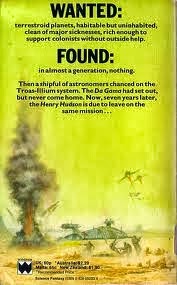"Warp drive" and "hyperdrive" are two science fiction (sf) cliches for faster than light interstellar travel (FTL). These terms may be used interchangeably, if, for example, interstellar journeys are made through a "warp" in "hyperspace." Poul Anderson is always careful to clarify what he means by such terminology and also to differentiate between the means of FTL used in different fictitious scenarios.
Thus, in his Technic Civilization History, "hyperspace" is not a fourth spatial dimension but a series of instantaneous quantum jumps through three dimensional space. Disappearing at point A and re-appearing at Point B, a ship does not move between A and B and therefore is not limited to light speed but instead has a much greater "pseudo-velocity."
The warp drive in his Planet Of No Return (London, 1971) differs from this.
(i) "It does not take appreciably more time and energy to go 100,000 light-years than to go one." (p. 20) Consequently, interesting but distant stars are investigated before nearer but ordinary ones.
(ii) Going into warp involves the ship's engines roaring as they approach "...the potentials beyond which the omega effect set[s] in." (p. 25) The crew feels dizzy as the ship leaves "...normal energy levels..." and as atoms readjust in non-Dirac matrices.
(iii) There is complete blackness outside the viewports.
(iv) The ship, now irrelevant to the universe, has nothing to accelerate or spin in relation to, but centrifugal force is generated by rotating the inner hull in relation to the outer.
(v) Anderson writes that:
"It was like an endless falling through nullity." (ibid.)
But surely there is nothing to fall in relation to? Except that the ship and its contents were in free fall in relation to each other until centrifugal force was generated?
The first page of Chapter 4, having described "warp," introduces the fifth of the seven human "Cast of Characters," Tetsuo Hideki, Manchurian organic chemist.

No comments:
Post a Comment